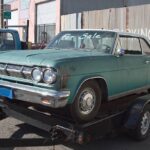Purchasing a used car can be an exciting endeavor, but it’s crucial to proceed with caution to avoid potential pitfalls, one of the most significant being unknowingly buying a stolen vehicle. Operating or possessing a stolen car can lead to severe legal repercussions, financial loss, and the distress of losing the vehicle. Therefore, understanding how to identify if a car is stolen before making a purchase is paramount. This article will guide you through the essential steps and signs to look for to help you determine if a vehicle might be stolen.
Visual Inspection for Signs of Theft
Before diving into VIN checks and official reports, a thorough visual inspection of the car can reveal initial red flags. Stolen vehicles often exhibit signs of forced entry or tampering.
Check for Broken Locks or Windows
Examine all doors, the trunk, and the hood for any signs of forced entry. Look for scratches, dents, or damage around the door locks, ignition, and steering column. Thieves often damage these areas when breaking into a car. Also, inspect the windows and windshield for cracks or replacements that might seem out of place for the car’s age and stated history. Mismatched or recently replaced glass could indicate a hasty repair after a break-in.
Inspect the Ignition and Steering Column
A key indicator of a stolen car is a tampered ignition or steering column. Check if the ignition switch is loose, damaged, or easily turned without a key. Similarly, look for signs of damage or tampering around the steering column, such as scratches, pry marks, or a loose plastic housing. These are common areas that thieves target to bypass the car’s security system.
Look for Mismatched VIN Plates
The Vehicle Identification Number (VIN) is a unique identifier for every car. Stolen cars might have had their original VIN plates removed and replaced with counterfeit ones to match fraudulent paperwork. Check the VIN plates located on the dashboard (visible through the windshield), the driver’s side doorjamb, and possibly under the hood on the engine block or chassis. Ensure that all VINs on the car match and appear to be professionally affixed and not tampered with. Mismatched VINs or signs of tampering are significant red flags.
Examine for Fresh Paint or Bodywork
While not always indicative of theft, freshly painted panels or recent bodywork can be a sign that a stolen car is being disguised or repaired after damage sustained during the theft or its aftermath. Look for inconsistencies in paint color or texture between different panels, overspray in door jambs or under moldings, and signs of recent welding or body filler. This is especially suspicious if the seller cannot provide a reasonable explanation for the recent repairs.
Be Wary of Suspicious Paperwork
Inconsistent or suspicious paperwork is a major red flag. Carefully examine the car’s title, registration, and any service records. Ensure the names and addresses on the documents match the seller’s information and are consistent with the car’s supposed history. Look for signs of alteration, erasures, or inconsistencies in fonts or paper types. Be especially cautious if the seller is reluctant to provide paperwork or offers only copies instead of original documents.
Utilizing VIN Check Services
Beyond visual inspection, using a VIN check service is crucial to verify a car’s history and check for theft records. A VIN check can reveal if a vehicle has been reported stolen, salvaged, or involved in major accidents.
What is a VIN and Where to Find It?
The Vehicle Identification Number (VIN) is a 17-character code unique to each vehicle. It’s like a car’s fingerprint and contains information about the car’s manufacturer, year, make, model, and more. You can typically find the VIN in several locations on a car:
- Dashboard: On the driver’s side dashboard, visible through the windshield.
- Driver’s Side Doorjamb: On a sticker attached to the doorjamb.
- Car’s Title and Registration: These documents will always list the car’s VIN.
- Insurance Card: Your car insurance card will also contain the VIN.
Always cross-reference the VIN in multiple locations to ensure consistency.
Using VINCheck (and Similar Services)
Services like VINCheck, offered by the National Insurance Crime Bureau (NICB), provide a free and quick way to check if a vehicle has been reported stolen or has a salvage history based on insurance records. To use VINCheck, you simply enter the VIN on their website.
VINCheck cross-references the VIN against participating insurer’s theft and salvage records. It’s important to note that VINCheck, like any free service, has limitations. It primarily relies on data from participating insurance companies and does not query law enforcement records or non-participating insurers.
Steps to Perform a VIN Check:
- Locate the VIN: Find the VIN from the car as described above.
- Visit the VINCheck Website: Go to the official NICB VINCheck website.
- Enter the VIN: Type the VIN into the designated input field.
- Review the Results: The service will provide results indicating if there are any theft or salvage records reported to participating insurers.
Limitations of Free VIN Checks and When to Use Paid Reports
While free VIN checks like VINCheck are valuable starting points, they are not comprehensive vehicle history reports. They may not include all theft records (especially those not reported to participating insurers) or other critical information like accident history, odometer discrepancies, or title issues.
For a more detailed vehicle history, consider using paid services like ClearVin, EpicVIN, VinAudit, or CycleVIN (for motorcycles). These services often compile data from a wider range of sources, including NMVTIS (National Motor Vehicle Title Information System), law enforcement agencies, and other databases, offering a more complete picture of a vehicle’s past.
When to consider a paid report:
- Buying from a private seller: When you have less assurance about the seller’s credibility.
- High-value vehicles: For more expensive cars where the risk of loss is greater.
- If red flags appear: If your visual inspection or free VIN check raises any concerns.
- Peace of mind: To gain comprehensive information and confidence in your purchase.
Other Verification Methods
In addition to visual checks and VIN services, consider these further steps to ensure you are not buying a stolen car.
Contacting Law Enforcement
If you have strong suspicions that a car might be stolen, you can contact your local law enforcement agency. Provide them with the VIN and explain your concerns. They may be able to check if the vehicle is listed as stolen in their databases. However, be cautious when contacting law enforcement from a private seller’s location.
Professional Inspection
Before finalizing any used car purchase, especially if you have any doubts, consider getting a pre-purchase inspection from a qualified mechanic. A professional mechanic can assess the car’s condition and potentially identify signs of theft or tampering that might not be obvious to an untrained eye.
Steps to Take If You Suspect a Stolen Car
If, at any point during your inspection or verification process, you strongly suspect that a car is stolen, it’s crucial to take the following steps:
- Do not buy the car: No matter how good the deal seems, avoid purchasing a vehicle you suspect is stolen.
- Cease communication with a suspicious seller: If the seller is evasive, uncooperative, or provides inconsistent information, disengage from the transaction.
- Report your suspicions: Contact your local law enforcement agency or the NICB to report your findings. Provide them with the VIN, seller information (if you have it), and the reasons for your suspicion.
Conclusion
Identifying a stolen car requires a combination of careful visual inspection and utilizing available verification resources. By being vigilant, knowing what signs to look for, and using VIN check services, you can significantly reduce the risk of purchasing a stolen vehicle. Always prioritize thorough due diligence and remember that if a deal seems too good to be true, it often is. Protect yourself from potential legal and financial headaches by taking the necessary steps to verify a used car’s legitimacy before you buy.

